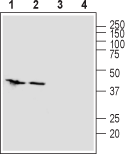Overview
- Peptide (C)GEPELLVWRPEAVASE, corresponding to amino acid residues 5-20 of human ZIP1 (Accession Q9NY26). Extracellular, N-terminus.
- Rat and mouse brain lysates. Human U-87 MG glioblastoma and MDA-231 breast adenocarcinoma cell lysates (1:200-1:1000).
 Western blot analysis of rat (lanes 1 and 3) and mouse (lanes 2 and 4) brain lysates:1,2. Anti-ZIP1 (SLC39A1) (extracellular) Antibody (#AZT-001), (1:200).
Western blot analysis of rat (lanes 1 and 3) and mouse (lanes 2 and 4) brain lysates:1,2. Anti-ZIP1 (SLC39A1) (extracellular) Antibody (#AZT-001), (1:200).
3,4. Anti-ZIP1 (SLC39A1) (extracellular) Antibody, preincubated with ZIP1/SLC39A1 (extracellular) Blocking Peptide (#BLP-ZT001). Western blot analysis of human U-87 MG glioblastoma cell lysate (lanes 1 and 3) and human MDA-231 breast adenocarcinoma cell lysate (lanes 2 and 4):1,2. Anti-ZIP1 (SLC39A1) (extracellular) Antibody (#AZT-001), (1:200).
Western blot analysis of human U-87 MG glioblastoma cell lysate (lanes 1 and 3) and human MDA-231 breast adenocarcinoma cell lysate (lanes 2 and 4):1,2. Anti-ZIP1 (SLC39A1) (extracellular) Antibody (#AZT-001), (1:200).
3,4. Anti-ZIP1 (SLC39A1) (extracellular) Antibody, preincubated with ZIP1/SLC39A1 (extracellular) Blocking Peptide (#BLP-ZT001).
- Rat brain sections (1:400).
Zinc uptake transporter, ZIP1, belongs to the SLC39 transporter family. This transport has the ability to increase zinc concentration when cellular zinc level is low, by active zinc transport into the cytoplasm from extracellular space of the cell or the intracellular storage compartment. Thus, zinc transport plays a crucial role in regulating cellular zinc homeostasis1-3.
Regulation and maintenance of proper concentration and distribution of cellular zinc are essential to the function, metabolism, growth, proliferation and survival of cells. Zinc deficiency can cause defects in the immune system, including abnormalities in T-cells, natural killer cells and monocytes, and reduction in antibody formation1,2.
In the human genome, 20 ZIP transporters have been identified. ZIP1 is encoded by the SLC39A1 gene3.
ZIP proteins are highly conserved. Members have eight predicted transmembrane (TM) domains with extracellular N- and C-termini. There is a long loop region harboring a histidine-rich domain between TM3 and TM4. Zinc uptake by ZIP1 is energy independent2.
ZIP1 is ubiquitously expressed in human tissues including blood, brain, gill, heart, intestine, liver, muscle, skin, spleen and kidney3.
Accumulation of zinc in prostate cells by ZIP1 inhibits their growth and proliferation. Therefore, ZIP1 is associated as a tumor suppressor gene in prostate cancer2.
